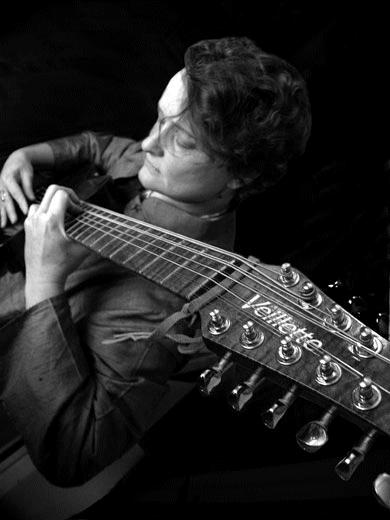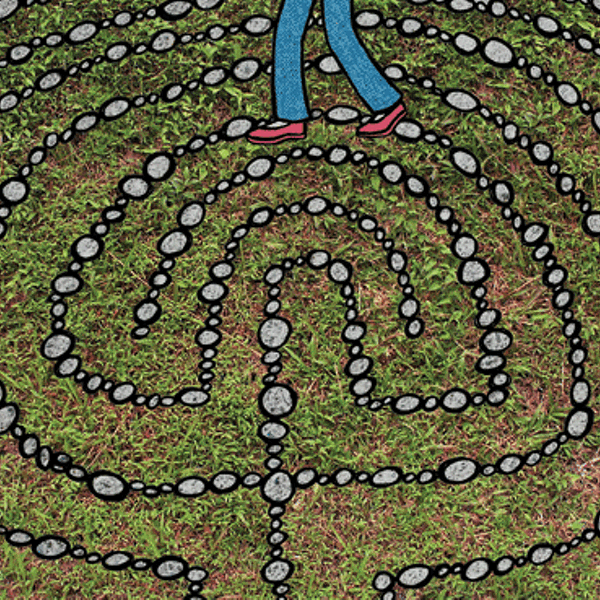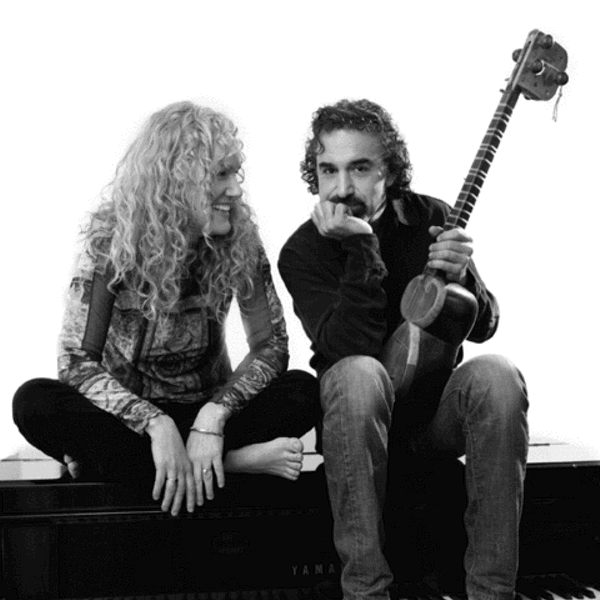I tread these ancient timeworn tracks / memorials to the syntax of this land / probe the molten silence of this place / and sense its pulse beat in the air / the call of man’s ancestral dreams / haunts the shelter of these stones / while shriveled leaves from borrowed skies / fall beneath the voids of emptiness
—FROM MALTESE POET RICHARD ENGLAND’S “THIS HOLY EARTH”
Long before the raising of Stonehenge, the megalithic temples of Malta took their place on the landscape. Considered the earliest free-standing monuments of stone in the world, they are older still than the Pyramids of Egypt. Built between 3800 and 2500BCE by a flourishing agrarian society, these buildings were “life centers”—gathering places for trade, festivals, rituals, and astronomical observation. It is said that they were built as shrines to the Great Goddess, and for some individuals a deep interest lies in the strange, inherent musical beat of this place, for it has a pulse of the Mysteries.
Local guitar virtuoso Lorah Yaccarino began pilgrimages to sacred sites throughout the Mediterranean over a decade ago after learning about healing the body with sound, reading books such as Kay Gardner’s Sounding the Inner Landscape. Yaccarino’s first trip to Malta was in 1992, and she set out for a profound experience.
“I wanted to find ways to incorporate my new philosophies into my art,” she says. “I had read about the temples in Malta, how a university team of scientists with ultrasensitive sound equipment had picked up pulses on some of the altar stones at certain temples during the summer solstice. They did a bunch of studies at the stone circles in England, too, but in Malta they actually picked up a pulse rhythm off one of the stones.”
Yaccarino had her Sony Walkman with her when she visited the various sites, one in particular being Ggantija, or “The Giant,” which stands on a hill on the Maltese island of Gozo. It’s a mother-daughter complex, huge stone forms shaped like female figures with temple rooms inside. It was here that Yaccarino placed her Walkman on the stones. She got a surprise when she returned to her hotel room that night.
“There was this heartbeat pulse rhythm happening,” she explains. “It wasn’t audible if you were there, you’d need to have something that went beyond the human ear to pick it up. And it was going at about 60 beats per minute. It just blew me away. I was like, holy shit...these rocks are really alive!”
I trace this temple’s winding paths / coiled in web-like spiral shapes / while echo messages from these stones / see me through the darkness of these years / work the colors of my life / carve alchemies in my changing bones / and guide me through the walls of time / where death exists no more —FROM “THIS HOLY EARTH”
From Malta, Yaccarino visited the stone circles in Cornwall and traveled all over Greece with her Walkman, recording as much as she could. At the temple to Athena in Delphi, she picked up a much faster rhythm, a constant 80 beats per minute melded with the sound of the wind. Upon returning to New York, she began incorporating the sounds into solo and group performances, using the tape as a background and layering sounds on top of it. Revisiting the Malta temples years later with even more sensitive equipment, she didn’t pick up any additional pulse rhythms. She did, however, record more thunder drum sounds which were incorporated into the beautifully serene track “Favorite Space,” which appears on the rhythmically textured CD Unravel The Moon, recorded with the ensemble Sacred Fire. Spoken word artist Michael Mulvey lulls Yaccarino’s accompanying tale: “Drifting through the temple door / I spy the wind rustling leaves on the floor / honey drips glowing, golden sunlight flowing / oceans mighty roar / I feel you Mother and know you well / breathe through me.”
Unravel The Moon features Yaccarino’s 12-string guitar and sound design with the 7-piece group on vocals, hurdy gurdy, bass, tablas, shakers, cymbals, chimes, steel pan, and doumbek. Blending spontaneous improv with prearranged grooves, the CD experiments with spoken word, vocal soundings, world percussion, and string melodies to create fluid, poignant soundscapes that move the listener through dynamic moods.
This cross-cultural exploration of sound had Yaccarino’s interest sufficiently piqued. She studied ancient scales and eastern-based music, particularly the ragas. “In India, they use ragas as their musical scales, and there are over 5,000 of them—2,500 feminine, 2,500 masculine. They represent different deities, different times of the day, and there’s one for just about every form and function.” Now using a combination of ragas and ancient Greek modes, Yaccarino felt her compositions were unlimited.
She also discovered Michael Bradford’s Applied General Dynamics Chart, which breaks down frequencies based on Hertz ranges and applies them to musical notes, colors and the four brain wave states: Beta, which is just above the threshold of awareness and deals with the five senses; Alpha, just below the threshold of awareness, which deals with emotion; Theta, beyond the threshold, which deals with intellect; and Delta, or transcendental, which is beyond logical experience.
“We’re all held together by frequencies,” she says, explaining the chart. “Everything on the planet has a vibration to it. For example, middle C correlates to the color red, which correlates to the Beta state. The Hertz ranges measured by some scientists at the stone circles in Cornwall and all over the world resonate at somewhat the same frequency, which is around 13 Hertz. This relates to the note F Sharp, the color green, and the brain wave state of Theta.”
Yaccarino wanted to push her music to the spiritual Delta state, so she began composing in B Minor. “It really expanded my creativity and turned me on to a whole host of sounds and experiences I’d never encountered. There’s so much to tune ourselves into sound-wise. I think there are muses out there that definitely guide us. Some of them are playful, some are sad, some are joyous, and if you allow yourself to get into a peaceful state, you can tune into them.”
According to Yaccarino, tuning into an audience also makes for a healing musical experience. She’s a big fan of improv for that reason. “I like playing improvisationally best. I do some set composed pieces, but if your stuff is all pre-programmed, you’re not connecting. If you allow yourself to be in the environment and feel the electricity in the air, the audience becomes part of the art and can become engrossed in it. If you go into a music store and go to the healing section, the shit’s god awful boring! It’s repetitive, layered, textured keyboard stuff with some angelic overtones and voices going ‘Ahhhhh!’ on and on. I don’t think that’s true healing music.”
Yaccarino has studied an expanded chakra system using 12 chakras, vowel sounds, and corresponding colors. Taking the vowel sounds and using the Applied General Dynamics Chart, another CD of consciousness was recorded, a live performance at the Rhinebeck Center for Performing Arts with Sacred Fire. Using a blend of experimental world fusion, the show evolved from interplay between the performers and their attunement with the audience. Other performances with her ensemble have employed different techniques to involve listeners. She’d ask for audience suggestions, such as picking a time of day or year—a full moon lunar eclipse in an autumn field, for example—or simply an emotion, and the group composed a piece using that suggestion. Or perhaps an audience member would pick a card from the Major Arcana and a musical piece would emerge from the tarot image.
Working at one time with another ensemble, Ritual Motion, Yaccarino mostly does solo work now. She performs occasionally at Kingston’s Deep Listening Space and is working on a solo CD, as well as another recording with Sacred Fire. A few more performances will appear in the spring.
Yaccarino’s definitely come a long way, morphing from a student at Brooklyn Academy of Music and Manhattan’s American Institute of Guitar, through the punk and party days on the Lower East Side, to years working in off-Broadway and multimedia performances. “But as I got older and became more aware of myself, I thought, where’s this all leading to? Where’s the connection? What’s the bigger picture here? What’s the best way I can serve the planet? I’ve discovered that a lot of my life is about service. It’s great to be an artist now who works with healing.”
For more on Yaccarino and her medicine music, visit www.sacredfireproductions.org or call (845)














